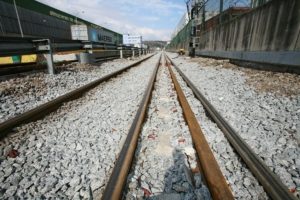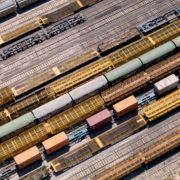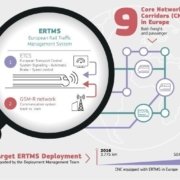Rail as key strategic freight transport
Railway is key part of the Spanish and European commitment to decarbonise the freight transport sector. Initiatives such as ‘ecoincentivos’, digitalisation, and automation, or “usage per load volume” are some of the challenges and characteristics that have been identified to help include rail as strategic freight transport.
Spain has the most kilometres of high-speed rail (3,402) in the European Union, and is the second country in the world (only surpassed by China). Nevertheless, despite these impressive numbers, beyond the road infrastructure equipment there are still several services linked to this transport that need to be developed, including the developments of digitalisation and the lack of equipment for its use.
Within the area of freight transport (discounting passenger traffic), the commitment to multimodal supply chains could be the key to achieving the ambitious objectives of the European Union toward environmental goals; especially by making use of an existing and easily applicable means of transport such as rail.

SURCO Operations II, que será en Madrid del 23 al 31 de enero 2023.
According to the Community of European Railway and Infrastructure Companies (CER), transport accounts for 31% of energy consumption of land transport in the European Union. Rail, for its part, is seven times more efficient than road transport. In terms of emissions, rail accounts for 0.4% of all transport. If only freight transport were to be taken into account, the railway would play a fundamental role to reach a sustainable system and meet the global objectives set, since the train emits 80% less CO2 than its equivalent by road, according to sources from El Economista. In addition to reducing emissions, it reduces external costs by up to 50%: a train replaces 40 lorries and thus helps decongest roads, reduce accidents and lowers noise. It also consumes six times less energy and is eight times better in terms of air pollution.
Within freight transport, commitment to using multimodal supply chains could be the key to achieving global objectives, especially by making use of an existing and easily applicable means of transport such as rail.
According to Xavier Flores, the General Secretary of Infrastructures of the Spanish Government, one of the challenges towards achieving the expansion of this system is the fact that only between 4% and 5% of the total freight is moved by rail in Spain.
The most efficient freight transport
The following factors can be attributed to the efficiency of rail transport:
- Low resistance: thanks to the wheel tread, the elastic deformation of the wheel-rail contact is comparatively low, as both elements are made of steel.
- Optimal aerodynamic drag: In long trains, the friction depends mainly on the cross-section of the vehicle, not the length. This results in minimal energy consumption.
- High-capacity transport: especially when the train reaches European standards of 740 m in length, and by boosting the electrification of railway lines, rail transport becomes a much more sustainable and competitive mode of transport than road for medium and long distances.
Key for decarbonizing the transport sector
There are several agreements that have created a roadmap for transport to reduce emissions: the 2030 Agenda, the Paris Agreement and the Green Deal in Europe are just some of them.
In 2011, the European Commission’s White Paper set a target of shifting 30% of road freight transport over 300 km to rail or inland waterways by 2030. Since then, European governments, institutions and companies have been working to reach agreements to tackle climate change. Combined or multimodal transport has been presented as the most economically and environmentally sustainable option solution for achieving this goal.
‘Ecoincentivos’: a commitment to the environment
To get on board the decarbonisation train and encourage the use of rail for freight transport, the Spanish Ministry of Transport, Mobility and Urban Agenda (Mitma) promoted the ‘eco-incentives’ programme. This was designed to last for the upcoming three years within the framework of the Recovery, Transformation and Resilience Plan.
This initiative has encountered some setbacks, as it is only applicable for those companies that have or will see a minimum growth of 8% in the volume of cargo transported. During the first half of the year this figure was being reached by almost all rail companies in the sector. Nevertheless, starting from June 2022, there was a radical turn downwards experienced by the dependence on such sectors as: chemical, aluminium, metallurgical or automotive, industries which in turn have also seen a fall in their activities, according to sources from the newspaper Transporte XXI.
Because of this, the Ministry of Transport is considering reformulating its aid plan in view of the decrease in activity suffered by railway companies in the second half of the year. However, the unused part of the total allocated budget for the current year (20 million) will not be lost, but will be rolled over to 2023.
Furthermore, in accordance with the proposals set out in the “Safe, Sustainable and Connected Mobility Strategy” 2030 of the Mitma (Ministry of Transport, Mobility and Urban Agenda of Spain), called “Intermodal and Smart Logistics Chains”, the Mercancías 30 initiative was announced and will be launched, aiming to promote rail freight transport as the backbone of multimodal logistics chains. From the dual perspective of the post-COVID19 economic recovery and the achievement of the objectives of decarbonisation and sustainability of transport. This programme will allocate around 8.8 billion euros for the development of rail freight, both for infrastructure (6.8 billion euros) and equipment (2 billion euros). All actions are to be carried out before 2030.
The long road towards digitisation
The road to rail digitisation is a long one, with outdated systems and obsolete technology being among the main challenges to optimisation. According to McKinsey’s report titled ‘Digitizing Europe’s railways: A call to action‘ (2020), despite its robustness, Europe’s railways have outdated systems that are increasingly difficult to maintain. Some major European railways have several types of interlockings, some of which are more than a century old and use very obsolete technology.
According to a PierNext article – an initiative of the Port Authority of Barcelona – to become the transport mode of the decarbonised Europe, railway must meet five digital axes:
-
Digitalising and interconnecting infrastructures
-
Automation as the basis for its operations and infrastructures
-
Processing and exploiting data
-
Run everything in the Cloud
-
Safety and security as top priorities
The European rail sector can continue to promote technology systems. Digitalisation is key to this, especially when looking to become the central freight transport system in Europe and Spain. The challenge is significant, as the window of opportunity is narrow, and regardless of their interests or wills, the whole industry must be willing to collaborate to drive change.
The potential gains in cost and capacity efficiency, as well as the benefits of reduced CO2 emissions, are considerable, both within and outside Spain and Europe. To achieve this, operators, governments and companies must cooperate and act to promote the use of rail and co-modality as the most economically and environmentally sustainable response to today’s global challenges.
Look out for our upcoming courses: SURCO Madrid 2023 – Escola Europea – Intermodal Transport



